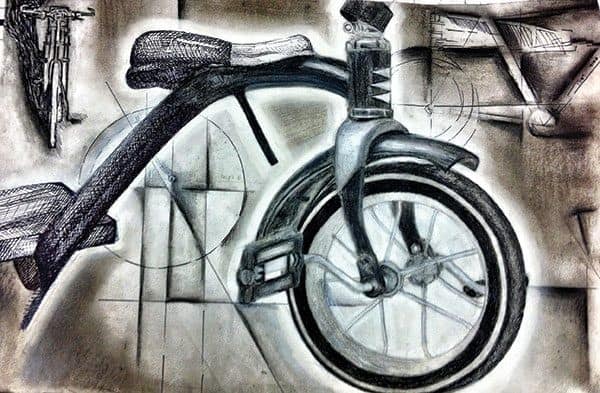I am always excited to introduce my students to the bike-drawing lesson in that I know they will be quite challenged, but I also know they are ready for the challenge because their Intro Art curricula and Art II lessons have prepared them well.
I think it’s extremely important to have our Art II students draw from life daily, but drawing bikes is essential in building up their portfolios. Many colleges and universities require a minimum of two bike studies, and often that number is higher. It is also important for scholarship opportunities because, let’s face it, drawing bikes is tough! Students have to look, they have to measure, they have to be exact, and they have to pay attention to details that often go unnoticed.

I have been teaching my bike study lesson for the past nine years, and this year we took it to the next level. In the past, I always had students draw several contour studies of our “hanging bike” in our room. These are generally quick sketches to loosen them up and calm their artistic nerves. Once these are complete, students begin focusing of specific areas of the bike and draw with graphite in full detail.
We discuss the ways in which the light reflects off of the metal and we discuss how we can show this using a variety of media so once their graphite study is complete, they move on to another area of the bike and use pen and ink and finally, they finish up their studies by the end of the week, using charcoal. Students are excited with their detailed work in that they are encouraged to take photos of the bike and they draw from both life and their photos, truly enhancing the ability to evaluate the details needed to make these drawings believable.
The most fun part of this lesson comes right when they think they are finished, this is when I give them three days to create a composition using their bike studies creatively! Students can create reliefs, collaged works and add mixed media into their negative space, while always considering the best ways to emphasize the bike work. These works remain black and white and are always a big hit when we display them in our “mini museum”!
UPDATE: One of the reasons I enjoy writing these lesson for Arts & Activities is to hear about how art educators are springboarding from my lessons and creating exciting new learning opportunities for their students. After doing this lesson for so many years, I decided to spice it up a bit this year. Dr. Lexi Cutcher, a colleague who was visiting from overseas, is a mark-making master artist. The two of us discussed ways to take this lesson and add simple mark-making activities to enhance the students’ final pieces, and push the in-process learning, as well.
Lexi’s idea was to have students use their whole body as they drew quick studies of the bike on 24″ x 36″ drawing paper, in 16 timed sections. Each section was done in 30 seconds, then 15 and then 10, and each section students had to switch hands!
It was beyond exciting to watch these students work quickly creating contour “bikeness” in graphite sticks. They were energized and after the first three, they lost their fear of failure and began to realize that these were simply studies, learning tools, which are all part of the art process!
Once they completed the first 16 timed studies, they turned their papers over and did another 16. But, this time they used ink and sticks, and again, the room palpitated with artistic excitement!





Drawing bikes is tough! Students have to look, they have to measure, they have to be exact, and they have to pay attention to details that often go unnoticed.
For the final project, students took their three detail studies and their mark-making studies and combined them into a new composition. I also had them incorporate one color into their piece and the results were spectacular! It’s always fun to see the explored art processes show up in the final works, I believe that equals “Learning at its Best!
A&A Contributing Editor Debi West, Ed.S, NBCT, is Art Dept. Chair at North Gwinnett High School in Suwanee, Ga.
Reprinted with permission from Arts & Activities Magazine. Visit their website: artsandactivities.com
The post Technical Meets Creative appeared first on Schoolyard Blog | Teacher Resources | School Specialty.